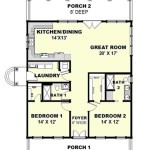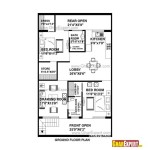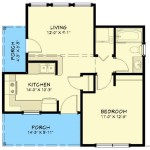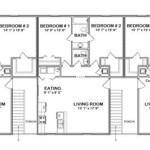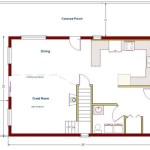Decoding the 2-Bedroom House Plan: A Dimensional Deep Dive
The allure of a 2-bedroom house plan stems from its versatility. It caters to individuals, couples, small families, and even those seeking a manageable and cost-effective retirement option. Beyond the basic room configuration, the true value of a house plan lies in its dimensional accuracy and careful space allocation. Understanding these dimensions is crucial for visualizing the space, planning furniture placement, and ensuring the design aligns with lifestyle needs and building regulations.
A 2-bedroom house plan, like any architectural blueprint, provides a detailed representation of the intended structure. It encompasses not only the layout of rooms but also critical information regarding dimensions, materials, and construction techniques. The dimensions noted on the plan dictate the overall size of each room, the width of hallways, the placement of doors and windows, and the height of ceilings. These are not arbitrary figures; they are determined by factors such as intended function, ergonomic considerations, and compliance with building codes regarding minimum habitable space requirements and accessibility.
Before embarking on a construction project, a thorough understanding of the dimensional aspects of a 2-bedroom house plan is paramount. This allows for informed decision-making, minimizing potential errors during construction and ultimately ensuring a comfortable and functional living space.
Key Point 1: Understanding the Fundamental Dimensions
The foundation of any successful 2-bedroom house plan lies in understanding its fundamental dimensions. These dimensions define the overall footprint of the house and the individual room sizes. Let's break down the core dimensional elements:
Overall Footprint: This refers to the total length and width of the house plan. It dictates the amount of land required and is a crucial factor in determining construction costs. The overall footprint is usually clearly stated on the plan, often represented as "Width x Length" (e.g., 30ft x 40ft). This dimension directly influences the available square footage, which is a primary consideration for prospective homeowners.
Room Dimensions: Each room is defined by its length, width, and height. These dimensions are critical for determining the usability of the space. A master bedroom, for instance, typically requires larger dimensions than a secondary bedroom to accommodate a king-size bed, dressers, and ample walking space. Living room dimensions are crucial for furniture arrangement and creating a comfortable gathering area. The kitchen's dimensions dictate the amount of counter space, storage capacity, and the feasibility of including a dining area. Dimensions are typically listed as "Length x Width" (e.g., 12ft x 14ft).
Wall Thickness: The thickness of the walls, both interior and exterior, also contributes to the overall dimensions. Exterior walls are typically thicker than interior walls, providing insulation and structural support. The thickness of walls should be accounted for when calculating usable floor space within each room. The plan will typically indicate the wall thickness, often as a note or specification. For instance, exterior walls might be listed as 6" thick, while interior walls are 4" thick. These seemingly small measurements can aggregate and impact the perceived spaciousness of the rooms.
Door and Window Dimensions: The dimensions of doors and windows are crucial for accessibility and natural light penetration. Door width must meet minimum requirements outlined in building codes, ensuring ease of passage for individuals with mobility impairments. Window dimensions dictate the amount of natural light entering each room, affecting the ambiance and potentially reducing energy consumption. The plan will specify the width and height of each door and window, often categorized by type (e.g., sliding glass door, casement window). These dimensions play a pivotal role in the aesthetics and functionality of the home.
Ceiling Height: While often overlooked, ceiling height significantly impacts the perceived spaciousness of a room. Standard ceiling heights are typically 8 feet, but higher ceilings, such as 9 or 10 feet, can create a more open and airy feel. The plan will usually indicate the ceiling height throughout the house. Variations in ceiling height can be incorporated into the design to define different areas or create a focal point.
Accurate interpretation of these fundamental dimensions is critical for understanding the spatial characteristics of the 2-bedroom house plan and ensuring that it aligns with individual needs and preferences.
Key Point 2: Analyzing Room Layout and Circulation
Beyond the individual room dimensions, the layout of the rooms and the circulation paths between them are crucial aspects of a 2-bedroom house plan. A well-designed layout optimizes the use of space and creates a comfortable and functional living environment. Circulation refers to the way people move through the house, and efficient circulation minimizes wasted space and ensures easy access to all areas.
Room Adjacency: The relationship between adjacent rooms is a critical factor in determining the overall functionality of the house. For example, the master bedroom should ideally be located away from the living area to provide privacy and quiet. The kitchen should be conveniently located near the dining area for ease of serving meals. The proximity of bedrooms to bathrooms is also a key consideration. The plan will clearly show the placement of each room relative to the others, revealing the intended flow of the house.
Hallway Width: Hallway width is crucial for comfortable passage and accessibility. Narrow hallways can create a cramped and claustrophobic feeling, while wider hallways provide ample space for movement, especially for individuals with mobility impairments. Building codes often specify minimum hallway widths for accessibility purposes. The plan will indicate the width of all hallways, ensuring that they meet these requirements and provide adequate space for circulation.
Door Placement: The placement of doors within each room significantly impacts furniture arrangement and traffic flow. Doors should be positioned to minimize interference with furniture and to provide easy access to adjacent spaces. The plan will show the swing direction of each door, allowing for careful consideration of furniture placement and potential obstructions. Poor door placement can disrupt the flow of the house and create awkward or inefficient spaces.
Window Placement: The placement of windows is not only about aesthetics; it also affects natural light distribution and ventilation. Windows should be strategically positioned to maximize natural light and provide cross-ventilation throughout the house. The plan will show the location and orientation of each window, allowing for assessment of its impact on light and airflow. Consideration should be given to the position of the sun at different times of the day when evaluating window placement.
Storage Space: Adequate storage space is essential for maintaining an organized and uncluttered home. Closets, pantries, and built-in storage solutions should be strategically located throughout the house. The plan will show the size and location of all storage areas, allowing for assessment of whether they meet the homeowner's needs. The presence of linen closets, coat closets, and general storage rooms significantly enhances the livability of the 2-bedroom house.
By carefully analyzing the room layout and circulation paths, potential bottlenecks and inefficiencies can be identified and addressed before construction begins. This ensures a comfortable, functional, and well-organized living space.
Key Point 3: Interpreting Details and Annotations
Beyond the basic dimensions and layout, a 2-bedroom house plan contains a wealth of detailed information in the form of annotations, symbols, and specifications. Understanding these details is essential for accurately interpreting the plan and making informed decisions about construction and materials.
Material Specifications: The plan will specify the materials to be used for various elements of the house, such as the foundation, walls, roof, and flooring. This information is critical for determining the cost of construction and ensuring that the materials meet building code requirements. Material specifications may include the type of wood for framing, the type of insulation for walls and ceilings, and the type of roofing material. These specifications often reference industry standards or specific manufacturers.
Electrical and Plumbing Symbols: The plan will use standard symbols to represent electrical outlets, switches, lighting fixtures, and plumbing fixtures. Understanding these symbols is essential for determining the location of electrical and plumbing infrastructure. The plan will typically include a legend explaining the meaning of each symbol. This information is critical for electricians and plumbers during the construction process.
Window and Door Schedules: The plan may include separate schedules listing the specifications for each window and door, including size, type, and manufacturer. This information is essential for ordering the correct windows and doors and ensuring that they meet the design requirements. The schedules may also include information on glazing type, frame material, and hardware finishes.
Construction Notes: The plan will often include notes providing specific instructions or clarifications regarding construction techniques or materials. These notes are essential for ensuring that the construction is performed correctly and that the house meets all applicable building codes. Construction notes may address issues such as foundation preparation, wall framing, and roof installation.
Scale: The plan will indicate the scale to which it is drawn, typically expressed as a ratio (e.g., 1/4" = 1'0"). Understanding the scale is essential for accurately measuring distances on the plan. Using a scale ruler or architectural scale, one can translate the measurements on the plan to actual dimensions in the real world.
Elevation Views: Elevation views show the exterior appearance of the house from different sides. These views provide a visual representation of the house's design and help to understand the relationship between the different elements of the facade. Elevation views often include details such as window trim, siding materials, and roof overhangs.
By carefully examining the details and annotations on the plan, potential issues can be identified and addressed before construction begins. This helps to ensure that the house is built according to the design specifications and that it meets all applicable building codes and regulations.

538 Sq Ft 2 Bedroom Single Floor Plan And Elevation Simple Plans Little House

Two Bedroom Small House Design Shd 2024030 Pinoy Eplans Plans Floor

Two Bedroom Small House Plan Cool Concepts Design Plans

2 Bedroom Designs You Can Easily Build For Less Than 1 5m Jenganami

A Two Dimensional Drawing Showing The Ground Floor Plan Of Bedroom Scientific Diagram

2 Bedroom Modular Home Floor Plans Rba Homes Bungalow Condo

Country Porches 2 Bedroom Cottage Style House Plan 5712

2 Bedroom Traditional House Plan Tr60as Inhouseplans Com

Simple 2 Bedroom House Plan 21271dr Architectural Designs Plans

Practical 2 Bedroom House Plan With L Shaped Kitchen


